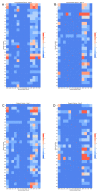Antimicrobial Resistance Patterns in Organic and Conventional Dairy Herds in Sweden
- PMID: 33233471
- PMCID: PMC7700389
- DOI: 10.3390/antibiotics9110834
Antimicrobial Resistance Patterns in Organic and Conventional Dairy Herds in Sweden
Abstract
Monitoring antimicrobial resistance (AMR) and use (AMU) is important for control. We used Escherichia coli from healthy young calves as an indicator to evaluate whether AMR patterns differ between Swedish organic and conventional dairy herds and whether the patterns could be related to AMU data. Samples were taken twice, in 30 organic and 30 conventional dairy herds. Selective culturing for Escherichia coli, without antibiotics and with nalidixic acid or tetracycline, was used to estimate the proportions of resistant isolates. Microdilution was used to determine the minimum inhibitory concentrations (MICs) for thirteen antimicrobial substances. AMU data were based on collection of empty drug packages. Less than 8% of the bacterial growth on non-selective plates was also found on selective plates with tetracycline, and 1% on plates with nalidixic acid. Despite some MIC variations, resistance patterns were largely similar in both periods, and between organic and conventional herds. For most substances, only a few isolates were classified as resistant. The most common resistances were against ampicillin, streptomycin, sulfamethoxazole, and tetracycline. No clear association with AMU could be found. The lack of difference between organic and conventional herds is likely due to a generally good animal health status and consequent low AMU in both categories.
Keywords: AMR; MDR; antibiotic; antibiotic resistance; antibiotic use; environment; livestock.
Conflict of interest statement
The authors declare no conflict of interest.
Figures





Similar articles
-
Herd-level relationship between antimicrobial use and presence or absence of antimicrobial resistance in gram-negative bovine mastitis pathogens on Canadian dairy farms.J Dairy Sci. 2013 Aug;96(8):4965-76. doi: 10.3168/jds.2012-5713. Epub 2013 Jun 13. J Dairy Sci. 2013. PMID: 23769367
-
Intramammary and systemic use of antimicrobials and their association with resistance in generic Escherichia coli recovered from fecal samples from Canadian dairy herds: A cross-sectional study.Prev Vet Med. 2023 Jul;216:105948. doi: 10.1016/j.prevetmed.2023.105948. Epub 2023 May 25. Prev Vet Med. 2023. PMID: 37263090
-
Antimicrobial use and its association with the isolation of and antimicrobial resistance in Campylobacter spp. recovered from fecal samples from Canadian dairy herds: A cross-sectional study.Prev Vet Med. 2023 Jun;215:105925. doi: 10.1016/j.prevetmed.2023.105925. Epub 2023 Apr 23. Prev Vet Med. 2023. PMID: 37104967
-
Invited Review: Antimicrobial Use and Antimicrobial Resistance in Pathogens Associated with Diarrhea and Pneumonia in Dairy Calves.Animals (Basel). 2022 Mar 18;12(6):771. doi: 10.3390/ani12060771. Animals (Basel). 2022. PMID: 35327168 Free PMC article. Review.
-
A Scoping Review of Antimicrobial Usage and Antimicrobial Resistance in Beef Cow-Calf Herds in the United States and Canada.Antibiotics (Basel). 2023 Jul 12;12(7):1177. doi: 10.3390/antibiotics12071177. Antibiotics (Basel). 2023. PMID: 37508273 Free PMC article.
Cited by
-
Antimicrobial resistance profiles of Escherichia coli and prevalence of extended-spectrum beta-lactamase-producing Enterobacteriaceae in calves from organic and conventional dairy farms in Switzerland.Microbiologyopen. 2022 Apr;11(2):e1269. doi: 10.1002/mbo3.1269. Microbiologyopen. 2022. PMID: 35478290 Free PMC article.
-
Dissemination of Resistant Escherichia coli Among Wild Birds, Rodents, Flies, and Calves on Dairy Farms.Front Microbiol. 2022 Apr 1;13:838339. doi: 10.3389/fmicb.2022.838339. eCollection 2022. Front Microbiol. 2022. PMID: 35432261 Free PMC article.
-
Effect of allogeneic pure platelet-rich plasma, sodium cloxacillin, and their combination for the treatment of subclinical mastitis in crossbred cows.Front Vet Sci. 2024 Aug 22;11:1432354. doi: 10.3389/fvets.2024.1432354. eCollection 2024. Front Vet Sci. 2024. PMID: 39239388 Free PMC article.
-
Antimicrobial Susceptibility in Respiratory Pathogens and Farm and Animal Variables in Weaned California Dairy Heifers: Logistic Regression and Bayesian Network Analyses.Antibiotics (Basel). 2024 Jan 4;13(1):50. doi: 10.3390/antibiotics13010050. Antibiotics (Basel). 2024. PMID: 38247609 Free PMC article.
-
Analysis of Antimicrobial Use and the Presence of Antimicrobial-Resistant Bacteria on Austrian Dairy Farms-A Pilot Study.Antibiotics (Basel). 2022 Jan 18;11(2):124. doi: 10.3390/antibiotics11020124. Antibiotics (Basel). 2022. PMID: 35203728 Free PMC article.
References
-
- O’Neill J. Wellcome Trust; London, UK: 2016. [(accessed on 1 September 2020)]. Tackling Drug Resistance Globally: Final Report. Available online: https://amr-review.org/sites/default/files/160525_Final%20paper_with%20c....
-
- Mölstad S., Löfmark S., Carlin K., Erntell M., Aspevall O., Blad L., Hanberger H., Hedin K., Hellman J., Norman C., et al. Lessons learnt during 20 years of the Swedish strategic programme against antibiotic resistance. Bull. World Health Organ. 2017;95:764–773. doi: 10.2471/BLT.16.184374. - DOI - PMC - PubMed
-
- Grundin J., Blanco-Penedo I., Fall N., Sternberg-Lewerin S. The Swedish Experience—A Summary of the Swedish Efforts towards a Low and Prudent Use of Antibiotics in Animal Production. SLU Future Animals, Nature and Health Report No. 5. [(accessed on 1 September 2020)];2020 Available online: https://www.slu.se/en/Collaborative-Centres-and-Projects/slu-future-anim...
-
- Swedish Public Health Agency, Swedish Board of Agriculture Swedish Work against Antibiotic Resistance—A One Health Approach. [(accessed on 1 September 2020)];2020 Available online: https://www2.jordbruksverket.se/download/18.693595921700d430c72b254f/158....
-
- OIE Annual Report on Antimicrobial Agents Intended for Use in Animals. [(accessed on 1 September 2020)];2018 Available online: https://rr-africa.oie.int/wp-content/uploads/2019/09/annual_report_amr_3....
Grants and funding
LinkOut - more resources
Full Text Sources

